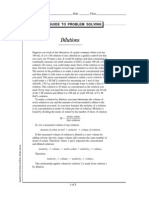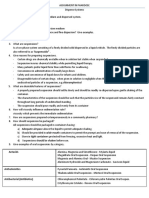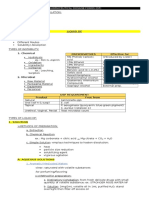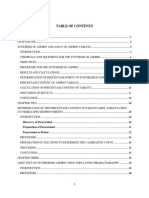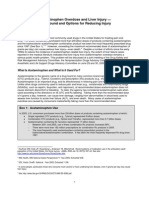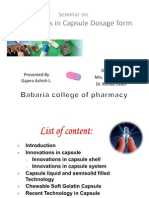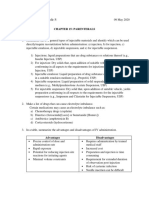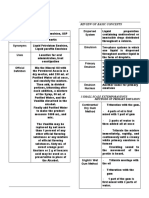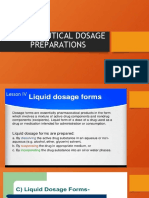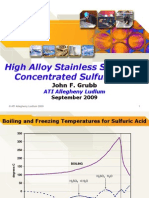RX 18-20
RX 18-20
Uploaded by
milkymilkyCopyright:
Available Formats
RX 18-20
RX 18-20
Uploaded by
milkymilkyOriginal Description:
Original Title
Copyright
Available Formats
Share this document
Did you find this document useful?
Is this content inappropriate?
Copyright:
Available Formats
RX 18-20
RX 18-20
Uploaded by
milkymilkyCopyright:
Available Formats
EXPT 18 – 20 EMULSIONS
SUSPENSIONS & EMULSIONS • Liquid preparations containing a mixture of oil and water that is rendered
Two Phased System homogenously by the addition of an emulsifying agent
o Dispersed phase or discontinuous phase • The emulsifying agent ensures that the dispersed phase is finely distributed
Dispersed particles or droplets throughout the dispersion medium as small globules
Particle size may vary from large to colloidal particles • TWO TYPES
o Dispersion medium or continuous phase o O/W – oil (dispersed phase) is dispersed through water
Must be homogenous for at least the period between shaking the (continuous phase) = common for oral preparations
container and removing the desired or required amount o W/O – vice versa = common for external preparations
Must bear the auxiliary label “Shake well”
Factors that determine the emulsion type:
SUSPENSIONS 1. Emulsifying agent
Liquid preparation that consist of solution dispersed throughout a liquid - surfactant that concentrate at the interface of 2 immiscible phases;
phase in which the particles are not soluble reduce the interfacial tension between the immiscible phases; provide
Liquid preparation can be made as solutions, suspension or emulsions a barrier around the droplet
depending on the physical state and solubility properties of the active 2. Phase ratio- Relative amount of oil and water
ingredient 3. Order of mixing- the phase that is being added, usually by portions tends
o Oral Solution-For drugs that is soluble in water or co-solvent to be the internal phase
o Emulsion- active ingredient is an immiscible liquid
o Suspension- drug is an insoluble soluble PHYSICAL INSTABILITIES
Desirable Properties Coalescence- merging of smaller droplet with larger droplet;
1. Fine, Uniform sized particle- gives optimal dissolution and adsorption Cracking – eventually separation of phases
2. Uniform dispersion of the particle in the liquid vehicle Creaming- migration of droplets on top/bottom of emulsion
o ensures uniform mixture & uniform dose
o wetting agent can be used – improves the ability of water to wet
hydrophobic powder (ex. Na Lauryl sulfate)
3. Slow setting of particle (slow sedimentation rate)
o fine, uniform size of particle
o ↑ density of the liquid
o adds viscosity- inducing agents/ suspending agents
o Example; Acacia, tragacanth, Na CMC, CMC
4. Ease of Redispersionwhen the product is shaken
o Solid should not form a hand “cake” on the bottom of the bottle
when the preparation is allowed to stand
18A: MAGNESIUM CARBONATE SUSPENSION
Orig Amt Reqd Amt
Menthol 2g 600 mg
Eucalyptus oil 10 mL 3 mL
Light MgCO3 7g 2.1 g
Water, to make 100 mL 30 mL
Mitte 100 mL
Sig. Place 1 tsp to 1 pint of hot water and inhale the vapor for 5 min
Desired Properties of Liquid Emulsion
Procedure
1. Fine droplet
1. Dissolve menthol in eucalyptus oil
2. Slow aggregation of the droplets and creaming of the product
2. Triturate MgCO3 into the mixture (in a separate container, add water to
3. Ease of redispersion when shaken
MgCO3 and triturate to a smooth paste
3. Qs ad water to 30 mL
METHOD OF PREPARATION
1. Continental or Dry Gum Method
Remarks
Menthol – freely soluble in volatile oil -1˚emulsion/nucleus 4:2:1 (O:W:EA)
Light magnesium carbonate – absorbs volatile oil; diffusible solid A. Triturate acacia or other Emulsifying agent with oil
2 TYPES OF SOLID B. Add water (added all at once) THEN triturate immediately, rapidly and
• Diffusable solid – not soluble in solvent; readily dispersed upon shaking continuously until the 1˚ emulsion that form is creamy white & produces
• Indiffusable solid – not soluble in solvent; doesn’t dispersed easily; requires a cracking sound (3 minutes)
used of suspending agent
2. English or Wet Gum Method
18B: PHENACETIN SUSPENSION
Orig Amt ReqdAmt -1˚ emulsion 4:2:1 (O:W:EA)
A. Triturate emulsifying agent with water- mucilage
Phenacetin 3g 1g
B. Add oil (added slowly in portions). Triturate
Caffeine 1g 0.33 g
Orange syrup 12 mL 4 mL
3. Bottle or Forbes Method 3:2:1 or 2:2:1 (O:W:EA)
Water, to make 90 mL 30 mL
M ft mixt -
Useful for extemporaneous preparation of emulsion from volatile oils
Sig. one tisp bid or oleageneous substance of lower viscosity
* 2% ACACIA = 0.6 g for 30 mL A. 1 part emulsifying agent + 2 parts oil- thoroughly shaken in capped
container
PROCEDURE B. Add water in portions- the mixture being thoroughly shaken after each
1. Triturate phenacetin in mortar addition
2. Add caffeine and acacia and orange syrup
3. Add ¾ vehicle and triturate to form smooth paste 4. Nascent Soap/ In situ soap Method
4. Qs ad water to final volume Calcium Soap (W/O emulsion) olive oil + water
A. Soap Emulsion 1:1
REMARKS B. The emulsifying agent is the Ca++ salt of the free fatty acids which is
1. Phenacetin: indiffusible solid; analgesic formed from the combination of 2 entities
2. Caffeine: diffusible; mild CNS stimulant
3. Orange syrup: flavorant
19: OIL OF TURPENTINE EMULSION
Orig Amt Reqd Amt
Oil of Turpentine (0.861g/mL) 8g 4.65 mL
Tragacanth 1g 1.33 g
Syrup 15mL 7.5 mL
Purified water, qs ad 60mL 30 mL
M. ft. emulsion
Sig. 1 tbsp bid
Procedure: Forbes/ Bottle Method (O:W:EA 3:2:1) – (4.65mL: 3.1mL:1.6g)
1. Oil + emulsifying agent in portion with intermittent agitation
2. Add 2.7 mL of water
3. Add syrup in portions with mixing
4. Qs ad water to final volume
Remarks:
1. Oil of turpentine: stimulant; diuretic; anthelmintic; carminative; expectorant
2. Tragacanth: emulsifying agent
3. Syrup: Sweetener
20: ZINC OXIDE - CALAMINE EMULSION
Orig Amt ReqdAmt
Zinc oxide 8g 4g
Calamine 8g 4g
Olive oil 30 mL 15 mL
Lime water 30 mL 15 mL
M
Sig. Apply to affected area OD
Procedure: Nascent Soap
1. Triturate Zinc oxide and calamine
2. Add olive oil in portion with trituration to form slummy
3. Add lime water in portions with trituration
Remarks
1. Zinc oxide: astringent, protective, antiseptic
2. Calamine: antipruritic
3. Olive oil: Emollient
4. Lime water: protective (gastric antacid)
You might also like
- Aspirin ExperimentDocument7 pagesAspirin ExperimentTrương Thị Bích LiễuNo ratings yet
- United Home Whitfield's OintmentDocument5 pagesUnited Home Whitfield's OintmentWalidur Rahman MridulNo ratings yet
- Dilution Problem Solving PDFDocument8 pagesDilution Problem Solving PDFลูซี้หมี ขวัญใจ ปัญญาสรกุลNo ratings yet
- Gas Absorption: Review QuestionsDocument4 pagesGas Absorption: Review QuestionsJohn P. Bandoquillo0% (1)
- Computations:: Weight of Solute (G) Volume of SolutionDocument2 pagesComputations:: Weight of Solute (G) Volume of SolutionMichael Torres100% (1)
- TanninsDocument13 pagesTanninsharishkumar kakrani50% (2)
- Isolation and Characterization of Nicotine From Tobacco LeavesDocument3 pagesIsolation and Characterization of Nicotine From Tobacco LeavesJohn Mark Flores Villena67% (3)
- Emulsions EditeddDocument63 pagesEmulsions EditeddFANTANo ratings yet
- Histamine, Serotonin, and Their AntagonistsDocument47 pagesHistamine, Serotonin, and Their Antagonistsbangkit99No ratings yet
- Good Manufacturing Principles - NewDocument34 pagesGood Manufacturing Principles - Newneeraj devarintiNo ratings yet
- SYRUPSDocument3 pagesSYRUPSAnnamae MartinNo ratings yet
- Tablet-Oral Solid Dosage FormDocument31 pagesTablet-Oral Solid Dosage FormHely PatelNo ratings yet
- Assay - Alumina and Magnesia Oral SuspensionDocument3 pagesAssay - Alumina and Magnesia Oral SuspensionmaimaiNo ratings yet
- Extraction of Nicotine (3-(1-methyl-2-pyrrolidinyl) pyridine) from Tobacco Leaves Separated from Gold Live Classic Brand™ Cigarettes by Solvent Extraction Approach and Characterization via IR AnalysisDocument6 pagesExtraction of Nicotine (3-(1-methyl-2-pyrrolidinyl) pyridine) from Tobacco Leaves Separated from Gold Live Classic Brand™ Cigarettes by Solvent Extraction Approach and Characterization via IR AnalysisOna RettaNo ratings yet
- Disperse SystemsDocument4 pagesDisperse SystemsAbby CruzNo ratings yet
- DdsDocument9 pagesDdsClaudette JunioNo ratings yet
- Ointment BasesDocument13 pagesOintment BasesJohaness Ronaldo Jr.No ratings yet
- Aspirin SynthesisDocument48 pagesAspirin SynthesisPaolo PepsNo ratings yet
- Preps 4-61Document57 pagesPreps 4-61fianaNo ratings yet
- Partition CoefficientDocument24 pagesPartition CoefficientdeshmukhgeolNo ratings yet
- Curcumin From Turemeric 2Document4 pagesCurcumin From Turemeric 2Raj Nemala Raj NemalaNo ratings yet
- Master Pharm Drug ListDocument1 pageMaster Pharm Drug ListMichelle StramNo ratings yet
- Experiment 2Document8 pagesExperiment 2Corina Faye RosarioNo ratings yet
- Paracetamol Literature - Navneet BaggaDocument21 pagesParacetamol Literature - Navneet BaggaNAVNEET BAGGANo ratings yet
- Act 9Document3 pagesAct 9Rei Deller TagiobonNo ratings yet
- Calamine LotionDocument2 pagesCalamine LotionHeba Ali0% (1)
- PH 107 DDS Lab Midterm NotesDocument11 pagesPH 107 DDS Lab Midterm NotesKrsna NaveraNo ratings yet
- 2 Pharmacognosy 416 Animal Drugs Honey GelatinDocument10 pages2 Pharmacognosy 416 Animal Drugs Honey GelatintiaraNo ratings yet
- PHA6111LAB - Finals ReviewerDocument7 pagesPHA6111LAB - Finals ReviewerMarie Eloise BugayongNo ratings yet
- Unit OintmentDocument39 pagesUnit OintmentEE KMNo ratings yet
- Structure Activity Relationship of Steroids: by Dr. Preetish Ku. PanigrahyDocument39 pagesStructure Activity Relationship of Steroids: by Dr. Preetish Ku. Panigrahypreetish50% (4)
- Applied Biochemistry (ODLICNO)Document49 pagesApplied Biochemistry (ODLICNO)milu1312No ratings yet
- Experiment 6 - Comparative Investigation of Organic Compounds Formal ReportDocument4 pagesExperiment 6 - Comparative Investigation of Organic Compounds Formal Reportayem94% (17)
- Analysis and Characterization of Cefixime by Using IR, HPLC and Gas ChromatographyDocument10 pagesAnalysis and Characterization of Cefixime by Using IR, HPLC and Gas ChromatographyFallahNo ratings yet
- Calamine LotionDocument1 pageCalamine LotionCarmelo Bautista100% (1)
- Innovation in Capsule Dosage FormDocument69 pagesInnovation in Capsule Dosage FormAshish Gajera100% (1)
- MCT Oil Product Data Sheet Gustav HeessDocument17 pagesMCT Oil Product Data Sheet Gustav HeessAdriana MariescuNo ratings yet
- Lab 15Document21 pagesLab 15zero contentNo ratings yet
- Amino AcidsDocument65 pagesAmino AcidsEmmanuel Chang100% (2)
- PHAR3 LAB-Elixirs&SpiritsDocument3 pagesPHAR3 LAB-Elixirs&SpiritsAbigail Beatrice LumbaoNo ratings yet
- CH241 6 Caffeine Extraction F14Document9 pagesCH241 6 Caffeine Extraction F14Fearless AngelNo ratings yet
- Lab 6 6. Saponin Glycosides Extraction and IdentificationDocument7 pagesLab 6 6. Saponin Glycosides Extraction and Identificationauob majadNo ratings yet
- Chapter 24 - Experiment B - Aspirin Synthesis and AnalysisDocument5 pagesChapter 24 - Experiment B - Aspirin Synthesis and AnalysisNeen NaazNo ratings yet
- Oral FormulationsDocument10 pagesOral FormulationsSiddhartha MuppallaNo ratings yet
- Extraction of Starch From Potato PDFDocument2 pagesExtraction of Starch From Potato PDFDale25% (4)
- Erythromycin PDFDocument13 pagesErythromycin PDFnita_ninotNo ratings yet
- Lesson 6 (New) Medication History InterviewDocument6 pagesLesson 6 (New) Medication History InterviewVincent Joshua TriboNo ratings yet
- Pharmacognosy Lecture # 5+6 (Tannins) (By, Sir Tanveer Khan)Document31 pagesPharmacognosy Lecture # 5+6 (Tannins) (By, Sir Tanveer Khan)Arslan Abdullah85% (13)
- Enteric Coated Aspirin Tablets FinalDocument72 pagesEnteric Coated Aspirin Tablets Finalronak_panchal_21No ratings yet
- 25 Rodriguez - Chapter 15-17Document9 pages25 Rodriguez - Chapter 15-17JANNIE BELLE RODRIGUEZNo ratings yet
- PHT 312 EmulsionDocument45 pagesPHT 312 EmulsionChristopher GambleNo ratings yet
- OintmentDocument6 pagesOintmentBSNo ratings yet
- Elements & CompoundsDocument11 pagesElements & CompoundsChing JunioNo ratings yet
- HPLC Analysis of Vitamin CDocument1 pageHPLC Analysis of Vitamin CHuong NguyenNo ratings yet
- C 14 SuspensionDocument119 pagesC 14 SuspensionVinod ChoudharyNo ratings yet
- Mineral Oil Emulsion: Dispersed System Official Title Category SynonymsDocument4 pagesMineral Oil Emulsion: Dispersed System Official Title Category SynonymsKate MendozaNo ratings yet
- 27 Mineral Oil EmulsionDocument7 pages27 Mineral Oil EmulsionLlang LleavNo ratings yet
- Phrmaceutical Dosage PreparationsDocument37 pagesPhrmaceutical Dosage PreparationsEleanorNo ratings yet
- PDFsam Merge-1Document90 pagesPDFsam Merge-1ikebuakupearlNo ratings yet
- Emulsion 2Document10 pagesEmulsion 2PH Amr FayedNo ratings yet
- 1 - OintmentsDocument33 pages1 - Ointmentsمحمد حسنNo ratings yet
- Wxs PDFDocument2 pagesWxs PDFoussama22No ratings yet
- Naranjo AlgorithmDocument3 pagesNaranjo AlgorithmmilkymilkyNo ratings yet
- Unit 1 Adr WordDocument4 pagesUnit 1 Adr WordmilkymilkyNo ratings yet
- Toxi - History and ScopeDocument1 pageToxi - History and ScopemilkymilkyNo ratings yet
- ASEAN Cosmetic Labeling Requirements DOCSDocument1 pageASEAN Cosmetic Labeling Requirements DOCSmilkymilkyNo ratings yet
- Office of The Secretary: San Lazaro Compound, Rizal Avenue, Sta. Cruz Manila, PhilippinesDocument92 pagesOffice of The Secretary: San Lazaro Compound, Rizal Avenue, Sta. Cruz Manila, PhilippinesmilkymilkyNo ratings yet
- Normas Pest Management ScienceDocument7 pagesNormas Pest Management ScienceCarine Mesquita Eduardo BarrosNo ratings yet
- Sulphuric AcidDocument37 pagesSulphuric AcidBaskaran SubramaniyanNo ratings yet
- Promedica CatalougeDocument20 pagesPromedica CatalougeMohammed Elgendy100% (1)
- 634729889337886250Document50 pages634729889337886250Santosh PayghanNo ratings yet
- PPE Hazard Assessment Certification Form: (Use A Separate Sheet For Each Job/task or Work Area)Document3 pagesPPE Hazard Assessment Certification Form: (Use A Separate Sheet For Each Job/task or Work Area)eastNo ratings yet
- Holey Fibers: Suchita KaundinDocument17 pagesHoley Fibers: Suchita KaundinIndra PrasetiyoNo ratings yet
- Lesson PlanDocument5 pagesLesson PlanShanoof Sharaf100% (1)
- Bes 121Document17 pagesBes 121Mariyah LykhaNo ratings yet
- Topics: Text Book PHYSICS For Scientists and Engineers With Modern Physics (6 Ed) by Serway & JewettDocument84 pagesTopics: Text Book PHYSICS For Scientists and Engineers With Modern Physics (6 Ed) by Serway & JewettBala KumarNo ratings yet
- Distillation of BenzeneDocument17 pagesDistillation of BenzeneAhmad MuzammilNo ratings yet
- DioriteDocument13 pagesDioriteGantang NugrahaNo ratings yet
- Robbery EssayDocument4 pagesRobbery Essayafhexydml100% (2)
- Vari Trane Product InfoDocument5 pagesVari Trane Product Infoqwerty_conan100% (1)
- Optical Properties and Failure Load of Thin CAD: CAM Ceramic VeneersDocument7 pagesOptical Properties and Failure Load of Thin CAD: CAM Ceramic VeneersjuanNo ratings yet
- R VAN Family Reference Sheet MetricDocument2 pagesR VAN Family Reference Sheet MetricHenry Michael Gómez SalazarNo ratings yet
- Siti Nur Afiqah Binti Mahazan - As2533a1 - Exp 4 - ChalconeDocument12 pagesSiti Nur Afiqah Binti Mahazan - As2533a1 - Exp 4 - ChalconeSITI NUR AFIQAH MAHAZANNo ratings yet
- Dipole Moment AcetoneDocument6 pagesDipole Moment AcetoneP NaveenNo ratings yet
- Emulsifying Wax (Peg-20 Stearate) Msds v1Document7 pagesEmulsifying Wax (Peg-20 Stearate) Msds v1Meidita Aulia Danus100% (1)
- Concept-Skills Development - PerdDocument65 pagesConcept-Skills Development - Perdjnbp1No ratings yet
- Lightning ArresterDocument25 pagesLightning ArresterMidhun Varghese100% (1)
- Modeling and Simulation of A Dynamic Turbofan Engine Using SimulinkDocument15 pagesModeling and Simulation of A Dynamic Turbofan Engine Using SimulinkAlexandru Sergiu MalancioiuNo ratings yet
- CCD PrincipalsDocument19 pagesCCD Principalsrahul09990No ratings yet
- KDocument10 pagesKfrezahcv7No ratings yet
- A Comparative Study of Wear Laws For Soft-On-hard Hip Implants Using A Mathematical Wear ModelDocument12 pagesA Comparative Study of Wear Laws For Soft-On-hard Hip Implants Using A Mathematical Wear ModelLeelakrishnan EthirajNo ratings yet
- Thick: CylindersDocument43 pagesThick: CylindersKartik BhararaNo ratings yet
- D974 39194Document7 pagesD974 39194Angela MoraNo ratings yet
- Deformations and Theoretical NuclearDocument28 pagesDeformations and Theoretical NuclearbinifsNo ratings yet
- Your Best Value For Routine GC and Gc/Ms Analysis: Agilent 7820A GC and Agilent 5977E Series GC/MSDDocument12 pagesYour Best Value For Routine GC and Gc/Ms Analysis: Agilent 7820A GC and Agilent 5977E Series GC/MSDkhalidshadidNo ratings yet


